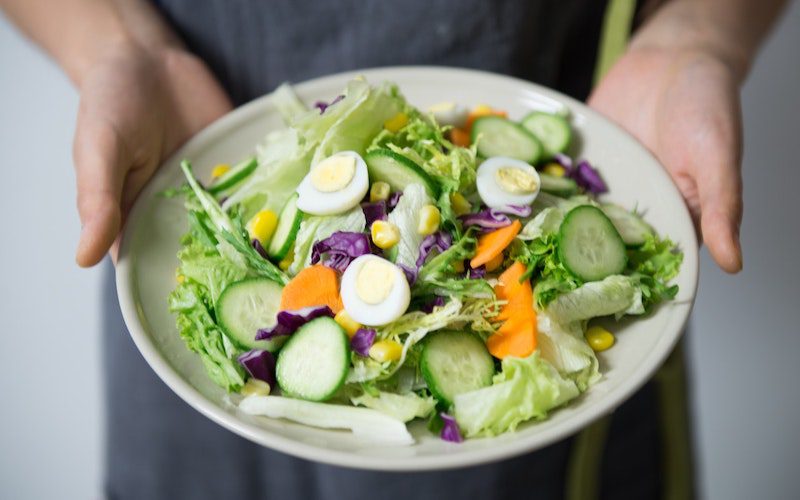
Diets are an especially fraught subject for people with chronic diseases. Some doctors give their patients complicated and restrictive dietary guidelines to help control their conditions or symptoms, but other doctors give dietary advice so vague as to be completely unhelpful: “limit your sugar intake” (to what? How much?) or “eat healthy” (what on Earth does that actually mean? Only 2 cheeseburgers per week? Veganism?). In addition, when you have a chronic disease, everyone you meet has a story to volunteer about their second cousin or someone they went to high school with who had the same chronic disease you have and they went on some weird diet and were miraculously cured of this incurable disease.
And then there are all the diets that purport to be the single best way to control your symptoms! Without drugs! But when you read the books and dig deep into what the diet plans actually are, they’re either very regimented (3 cups each of 3 different kinds of veggies each day! Organ meats precisely twice a week! All meals must have the same glycemic load!) or overly restrictive (no meat, no dairy, no oil, no sugar, no gluten, no white flour!). The rules and restrictions make it difficult to enjoy meals at restaurants or with family and friends, because many restaurants may not have anything on the menu that’s allowed by your diet. You may find yourself having to interrupt the flow of conversation to order a dish with lots of substitutions, or ordering a side salad and pretending that you’re not that hungry and happy to watch everyone else dig into burgers, steak, or cheesy pasta.
Healthy Eating Is More Time-Consuming and Expensive
Not to mention, if you’re on a restrictive diet, you’re probably cooking at home more often, and you’ll have to spend a lot more time in the kitchen, making things from scratch so you have control over what goes into your meals, and you may be spending more money at the grocery store on fresh and organic produce and specialty items.
Restrictive special diets can be expensive, stressful, and even exhausting. But if complying with the weird diet means feeling better, or getting symptoms under control, isn’t it worth it? Maybe. If you have an allergy or intolerance to gluten, soy, dairy, or another common foodstuff, it’s certainly a good idea to avoid it completely.
Is Fiber a Simpler Solution?
But what if healthy eating could be simpler than all kinds of rules? What if all we have to do is eat more fiber? After all, for all the disagreements between specialty diets, the part they seem consistent about is vegetables. Granted, there’s some disagreement about fruit, since some fruits have a fair amount of natural sugars in them, and beans, which pack a lot of complex carbs in with the fiber and protein. But everyone agrees that eating more veggies is good for all of us, especially the green leafy ones. The Atlantic article, “Just Eat More Fiber,” points out that eating a lot more fiber than most Americans do can help us lose weight, grow healthy microflora in our guts, and lower inflammation, among other benefits. The USDA recommends we eat about 30 grams of fiber per day, and most of us are getting about half that. People living in hunter-gatherer societies get about 100 grams of fiber per day, and they have much healthier gut biomes than Americans do.
How much overlap is there between your complicated diet of choice and the recommendation to just eat a lot of veggies, whole grains, fruit, and beans? If you focused on adding more of those foods to your diet, and substituting high-fiber foods for lower-fiber ones, would that alone accomplish 90% of your diet goals? Maybe eating healthfully can be simpler than swearing off lots of common ingredients or relentlessly tracking everything you put in your mouth.
Where’s the Fiber? How is this Easier?
Generally, there’s a lot of fiber in vegetables, fruit, whole grains, and beans. There’s little to no fiber in meat, dairy, butter and oils, white flour, and refined grains, like you’d find in processed snacks. So, how exactly do we get more fiber? We’re busy already, before the weird diets. Who has time to do more cooking or shopping? Here are a few easy ways to get more fiber:
Buy whole grain pasta and choose brown rice over white;
Keep fresh fruit in your kitchen, things that don’t need any preparation like apples, pears, oranges, grapes, and bananas;
Buy vegetables you like to eat raw, like carrots, celery, bell peppers, tomatoes, or broccoli, and clean and slice them right when you get home from the store, so you’ll have veggie sticks on hand in the fridge.
Keep bags of frozen greens on hand to add to soups, stews, or whatever you’re cooking.
Green smoothies are a health food trend, and they can sound complicated or not very tasty, but they can be both easy and delicious. To make an easy and sweet green smoothie, combine a frozen banana, a cup of whatever type of milk you drink, and a few handfuls of fresh spinach or kale in a blender and blend till smooth. Enjoy immediately.
Reality Check–How Might “Just Eat More Fiber” Work in Practice?
The remaining question for each of us to answer for ourselves is, what compromises to we have to make to eat more fiber? Is broccoli (high-fiber) only tasty with cheese (no fiber) on it? Do you need butter on your popcorn (a whole grain)? How little of the cheese and butter can you get away with? What toppings and condiments can you use that are healthier?
And of course, when we talk about managing chronic diseases, it’s a long term process, and our dietary choices are the same. Making a few changes at a time that you can stick with is going to be better in the long run than throwing out everything in your cupboards and trying to change everything at once.

